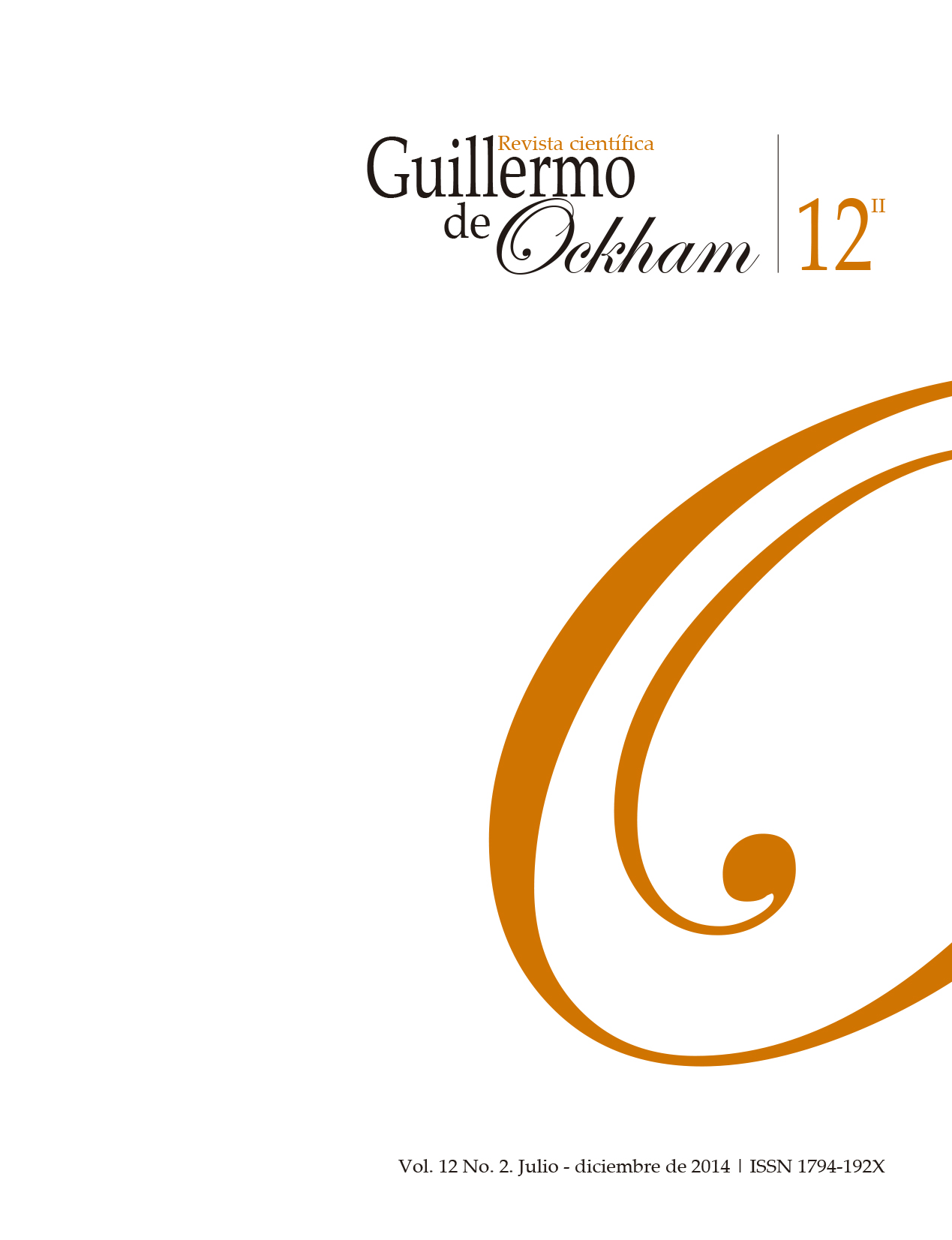The Revista Guillermo de Ockham provides an immediate and open access to its content, based on the principle of offering the public a free access to investigations to provide a global interchange of knowledge.
Unless otherwise established, the contents of this journal has a license with Creative Commons Attribution-NonCommercial-NoDerivatives 4.0 International (CC BY-NC-ND 4.0) http://creativecommons.org/licenses/by-nc-nd/4.0/
- Attribution: You must give appropriate credit, provide a link to the license, and indicate if changes were made. You may do so in any reasonable manner, but not in any way that suggests the licensor endorses you or your use.
- NonCommercial: You may not use the material for commercial purposes.
- NoDerivatives: If you remix, transform, or build upon the material, you may not distribute the modified material.
- No additional restrictions: You may not apply legal terms or technological measures that legally restrict others from doing anything the license permits.
Abstract
de una actividad consistente en reproducir la música en eventos sociales, fiestas, discotecas y en la radio, llevada a cabo por personas conocidas en todo el mundo como disc jockeys (DJ's). El estudio contó con la participación de cincuenta de estos profesionales de diferentes regiones de Colombia, a quienes se les suministró una encuesta electrónica que indagaba acerca de los géneros musicales, los formatos de uso actual, las percepciones y sus posturas frente al ejercicio profesional. Finalmente, se postula una línea de investigación en el campo de la psicoacústica, cuyo fin es abordar un fenómeno que todavía no es objeto de los desarrollos tecnológicos.
References
Bakker, J., & Bakker, T. (2006). The club DJ: A semiotic and interactionist analysis. Symbolic Interaction, 29(1), 71-82.
Beamish, T., Maclean, K., & Fels, S. (2004). Manipulating music: Multimodal interaction for DJs. Letter Chi, 327-334.
Rivero, D. (2008). Introducción a la metodolog ía de la investigación. México: Editorial Shalom.
Brice, R. (2001). Music engineering: The electronics of playing and recording. Oxford: Newnes.
Broughton, F., & Brewster, B. (2003). Manual del DJ, el arte y la ciencia de pinchar discos. Barcelona: Robinbook.
Chautrand, E. (2004). Música Digital. Barcelona: ENI.
Cliff, D. (2000). Hang the DJ: Automatic sequencing and seamless mixing of dance-music tracks. HP Laboratories Bristol, 104.
Emley, J. (2011). The Laptop DJ Handbook: Setups and Techniques of the Modern Performer. Boston: Course Technology, Cengage Learning.
Forsyth, A. (2009). 'Lager, lager shouting': The role of music and DJs in nightclub disorder control. Adicciones, 24(1), 327-345.
Fresh, D. C. (2004). How to be a DJ. Boston: Thomson Course Technology PTR.
Fries, M., & Fries, B. (2005). Audio digital práctico. Madrid: Anaya.
Hacker, S. (2000). MP3: The Definitive Guide. Sebastopol, CA: O'Reilly.
Hansen, K., & Bresin, R. (2010). The skipproof virtual turntable for high-level control of scratching. Computer Music Journal, 34(2), 39-50.
Hernández, R., Fernández, C., & Baptista, M. (2010). Metodología de la investigación. México: McGraw Hill.
Lingel, J. (2012). "We realized we had to become librarians": DJs, information practices and music libraries. ACM International Conference Proceeding Series (569-571).
Lopes, P., Ferreira, A., & Madeiras, J. (2010). Multitouch interactive DJing surface. ACM International Conference Proceeding Serie.
O'malley, Z., & Mac, R. (8 de Agosto de 2013). Counting Down The World's Highest-Paid DJs. Recuperado de http://www.forbes.com/pictures/eeel45egemd/1-calvin-harris-46-million-5/
Palomo, M. (1995). El estudio de grabación personal. Madrid: Amusic.
Pfadenhauer, M. (2009). The Lord of the Loops. Observations at the Club Culture DJ-Desk. Forum Qualitive Social Research, 10(3),
Recuero, M. (2000). Ingeniería Acústica. Madrid: Paraninfo.
Sanz, E. (20 de Noviembre de 2012). ¿Quién fué el primer DJ de la historia? Revista Muy Interesante. Recuperado de http://goo.gl/gex48I
Sellars, A. (1998). The influence of dance music on the UK youth tourism market. Tourism Management, 19(6), 611-615.
Snowman, R. (2014). Dance music manual tools, toys and techniques. New York: Focal Press.
Stevenson, J. (2006). DJing for dummies. Chichester, West Sussex: John Wiley & Sons.
Webber, S. (2008). DJ Skills The Essential Guide To Mixing And Scraching. London: Focal Press.
Zemon, S. (2010). La Maestría del Dj Móvil: Negocios, Ventas y Mercadotecnia. New York: Promobiledj.
































